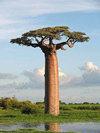Genetic diversity of Malagasy baobabs: implications for conservation
IF 0.6
4区 生物学
Q4 PLANT SCIENCES
引用次数: 1
Abstract
ABSTRACT Assessing the genetic diversity of species and populations is critical for evaluating extinction vulnerability and provides important information for identifying populations of concern and/or those that should be targeted for breeding material. Baobabs (Adansonia L.) are botanical icons for conservation, with increasing attention regarding their threatened status from both scientists and non-scientists alike. Baobabs are of particular interest especially in Madagascar, where six of the eight species are endemic, and three are listed as Endangered or Critically Endangered by the International Union for Conservation of Nature (IUCN). Although A. madagascariensis Baill., A. rubrostipa Jum. & H. Perrier and A. za Baill. are more widespread and classified by IUCN as Least Concern, they show regional variation, which may reflect hidden genetic diversity or even the existence of cryptic species. Here we assess the genetic diversity of the Malagasy baobabs to serve as a basis for future conservation and management planning. Our study used a targeted sequence capture approach (hybrid enrichment) to obtain hundreds of low-copy nuclear loci with phased alleles to assess genetic diversity in the six species and their major regional subpopulations. We discuss the implications of proper delineation of species taxonomy for management issues associated with conservation. We hope such genetic information will guide more targeted population genetic assessments and inform conservation and management efforts, including identification of isolated or disjunct populations that may warrant targeted actions.马达加斯加猴面包树的遗传多样性及其保护意义
评估物种和种群的遗传多样性对于评估灭绝脆弱性至关重要,并为确定关注种群和/或应作为育种材料目标的种群提供重要信息。猴面包树(猴面包树)是植物保护的标志,越来越受到科学家和非科学家的关注。猴面包树在马达加斯加尤其引人注目,8种猴面包树中有6种是当地特有的,其中3种被国际自然保护联盟(IUCN)列为濒危或极度濒危物种。尽管A. madagascar。A. rubrostipa Jum;& H. Perrier和A. za Baill。分布较广,被IUCN列为“最不受关注”(Least Concern)的物种,它们表现出区域差异,这可能反映了隐藏的遗传多样性,甚至是隐藏物种的存在。在此,我们评估了马达加斯加猴面包树的遗传多样性,作为未来保护和管理规划的基础。本研究采用靶向序列捕获方法(杂交富集)获得了数百个具有阶段性等位基因的低拷贝核位点,以评估6个物种及其主要区域亚群的遗传多样性。我们讨论了物种分类的正确界定对保护相关管理问题的意义。我们希望这些遗传信息将指导更有针对性的种群遗传评估,并为保护和管理工作提供信息,包括确定可能需要采取有针对性行动的孤立或分离种群。
本文章由计算机程序翻译,如有差异,请以英文原文为准。
求助全文
约1分钟内获得全文
求助全文
来源期刊

Adansonia
生物-植物科学
CiteScore
1.30
自引率
12.50%
发文量
24
审稿时长
>12 weeks
期刊介绍:
Adansonia is a fast-track and peer-reviewed journal of plant biology, devoted to the inventory, analysis and interpretation of vascular plants biodiversity. It publishes original results, in French or English, of botanical research, particularly in systematics and related fields: morphology, anatomy, biology, ecology, phylogeny, biogeography, etc. All articles published in Adansonia are compliant with the different nomenclatural codes. A copyright assignment will be signed by the authors before publication.
 求助内容:
求助内容: 应助结果提醒方式:
应助结果提醒方式:


